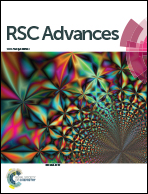Novel one-pot synthesis of a library of 2-aryloxy-1,4-naphthoquinone derivatives. Determination of antifungal and antibacterial activity†
Abstract
The development of new antibiotics and inexpensive antifungals is an important field of research. Based on the privileged pharmacophore of lawsone, a series of phenolic ether derivatives of 1,4-naphthoquinone were synthesized easily in one step in reasonable yields. All the new compounds were characterized and tested as potential antifungal and antibacterial agents against Candida albicans, Escherichia coli and Staphylococcus aureus. Compound 55 has significant antibacterial action (as good as or better than the controls) against E. coli and S. aureus. Against C. albicans, compounds 38, 46, 47 and 60 were the best candidates as antifungals. Using a qualitative structure–activity analysis, a correlation between molar mass and antimicrobial activity was identified, regardless of the substituent group on the phenolic moiety, except for 55 and 63, where electronic effects seem more important. An in silico evaluation of the absorption, distribution, metabolism and excretion (ADME) for 37, 50, 55 and 63 was made, indicating that the classic Lipinski's rule of five applies in all cases.



 Please wait while we load your content...
Please wait while we load your content...